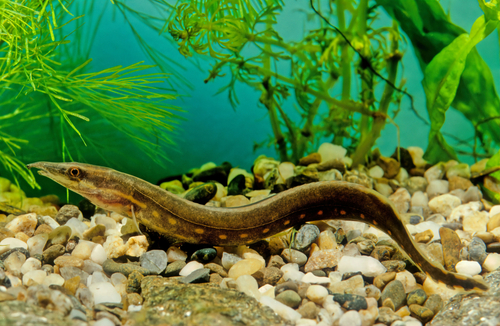Eels are like the snakes of the sea; even though many see them as scary, they are undoubtedly fascinating creatures. Watching one slither around in the water, it’s evident that an eel is one marvelous fish. But there are at least 15 popular fish that look like eels that are just as interesting to learn about.
Some fish that look like eels even have the word eel in their name despite not being eels. Many of the fish on this list are often mistaken for being eels by their physical appearance alone.
It’s only when inspecting these fish at close range – which unfortunately, many can’t do outside of pictures – that you’re able to spot the differences in these fish.
The list below are the fish that most closely resemble eels, some of which you’ve likely heard of before.
- Lamprey
- Rock Gunnel
- Fire Eel
- Bichir
- Kuhli Loach
- Electric Eel
- Peacock Eel
- Eel-Tailed Catfish
- Spiny Eel
- Dragon Goby
- Moray Eel
- Gollum Snakehead
- Dragon Eel
- Zig Zag Eel
- West African Lungfish
- Cutlassfish
- Reedfish
Contents
Fish That Look Like Eels
Other similar posts:
- Popular Fish With Yellow Stripes
- Popular Fish That Look Like Sharks
- Popular Fish With Black Stripes
- Popular Fish That Look Like Snakes
1. Lamprey
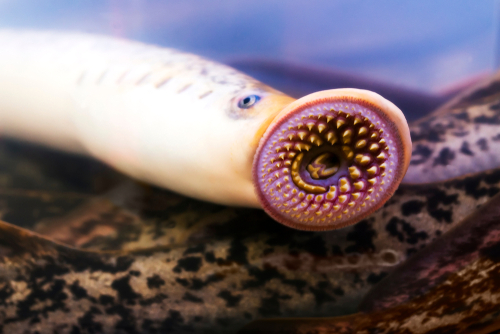
- Scientific Name: Petromyzon marinus
- Diet: The lamprey either sucks blood (for carnivorous lampreys) or larvae reserves (non-carnivorous lampreys).
There are a few different variations of lampreys within the family of fish, and many of them bear striking similarity to an eel. In fact, many who aren’t familiar with lampreys often mistake them for a type of eel.
One of the most distinct features that sets the lamprey apart from the eel is their strange mouths, which sucks in its food before chewing it up with its teeth.
The lamprey enjoys fairly calm and unobstructed waters, and are known for being able to swim long distances as they please. They can grow to become up to 40 inches long, though their average length when full grown has quite the variation.
Their bodies don’t have any scales, but they do have several gills on their sides as well as a large nostril at the top of their head.
2. Rock Gunnel
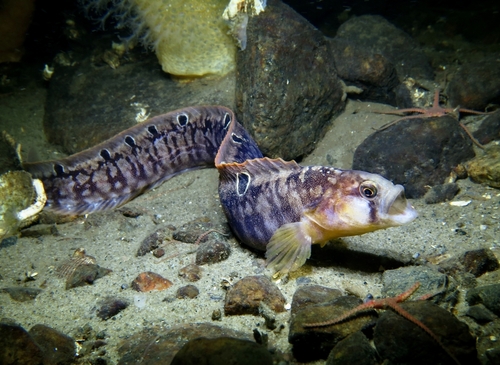
- Scientific Name: Pholis gunnellus
- Diet: In an aquarium, the rock gunnel prefers live feed; in the wild, they will feed on mollusks, crustaceans, or polychaetes.
It would be very easy to mistake a rock gunnel for an eel if you saw one swimming around given how similar the two fish are. Not only is the rock gunnel a long fish, but they have a similar flat appearance to an eel as well. The rock gunnel is usually found swimming around more shallow parts of the Atlantic Ocean.
Like an eel, the rock gunnel also feels slimy and has the same wet look as an eel does. Their fins, as well as their placement along the body, are also very much alike. Other than that, these two fish aren’t fans of the same kind of water. The rock gunnel also grows to be much smaller at maturity than an eel does.
3. Fire Eel
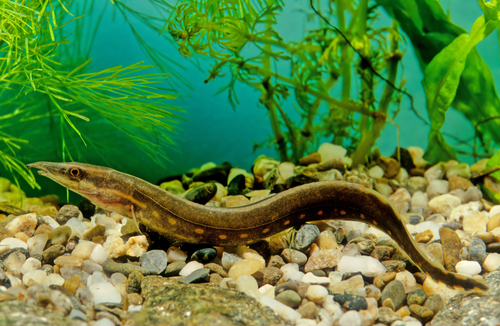
- Scientific Name: Mastacembelus erythrotaenia
- Diet: Fire eels are omnivores who enjoy small fish, plants, crustaceans, and insect larvae among other things.
The fire eel is not actually an eel despite what its name suggests. Like an authentic eel, the fire eel is a very thin and cylindrical fish that can grow very large; fire eels are known to grow up to one meter long.
The fire eel also looks a lot like an eel because of where their various fins are positioned on the body.
4. Bichir
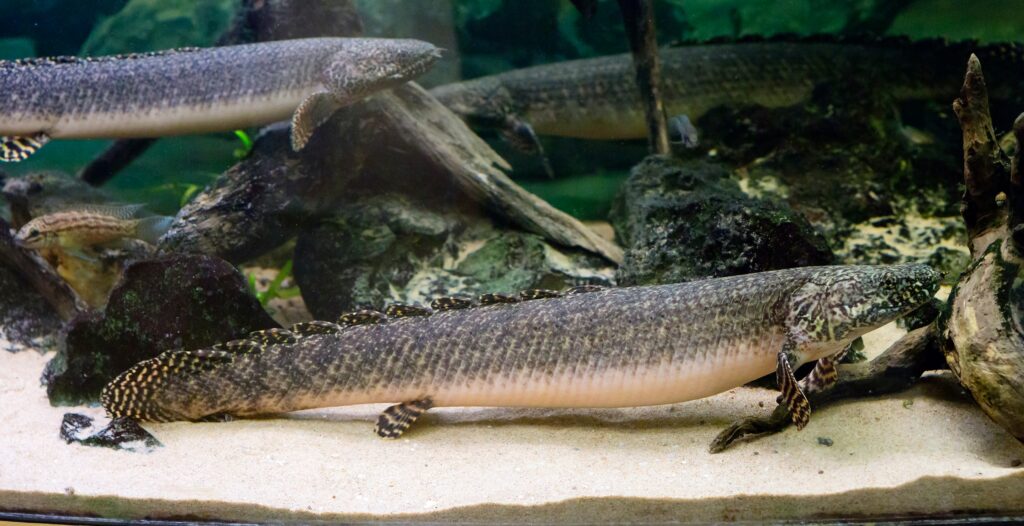
- Scientific Name: Polypteridae
- Diet: The bichir eats insects, crustaceans, and small vertebrates; when in the aquarium, they enjoy bloodworms.
The bichir is a very striking fish in its appearance. They mimic an eel in their visage until you get towards the end of their bodies, where you can see a soft tail.
They also have several scales that jut up from their backs, which has earned them the moniker of dinosaur eel. Unlike the eel, the bichir has stiff scales and doesn’t produce any slime.
Bichirs also have a long body like an eel does which leads to the common misidentification. A bichir also has a series of spots that run from the top of their heads to their tails. This fish has been found living in various parts of Africa and enjoys freshwater bodies of water.
5. Kuhli Loach
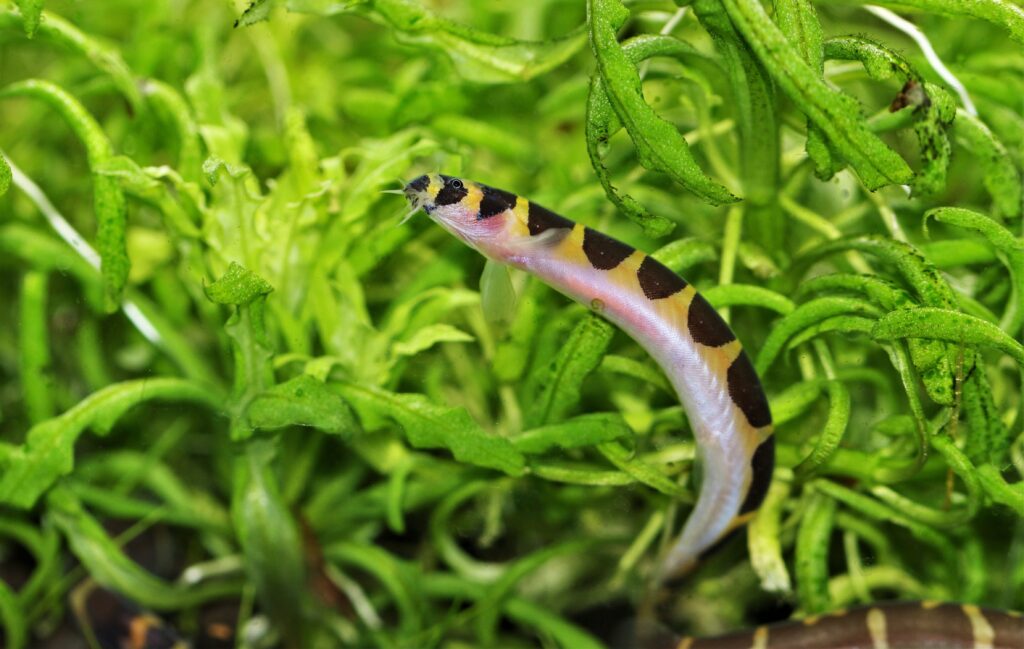
- Scientific Name: Pangio kuhlii
- Diet: A kuhli loach likes to scavenge, enjoying any scraps they can find as well as fish eggs and larvae.
The Kuhli Loach is an native fish to various parts of Asia, and while they are much smaller than some eels, they do look very similar in terms of their long bodies. They are thin fish like eels, have similar fin placement to eels, and they also have the same type of swimming patterns.
One way you can tell these two types of fish apart besides their size is the Kuhli Loach’s unique coloring. They feature several brown bars along their body, with the interesting pattern earning them the nickname of a leopard loach.
6. Electric Eel
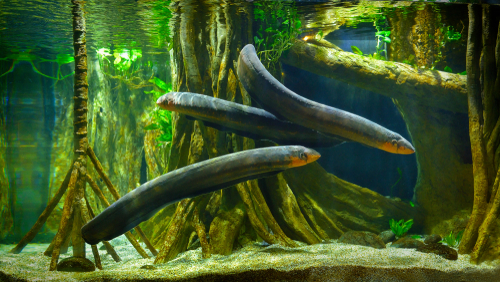
- Scientific Name: Electrophorus electricus
- Diet: Electric eels are carnivores who eat other fish, as well as crustaceans and insects.
Most would be shocked to realize that the electric eel, one of the most well-known eels, is actually not an eel. This fascinating fish really does generate electricity, however, so as much as you might want to get close to one, it’s not recommended.
They do have the same type of long body that an eel does, and can grow to be almost 50 pounds. They also have anal fins like an eel, and don’t have any pelvic fins.
7. Spiny Eel
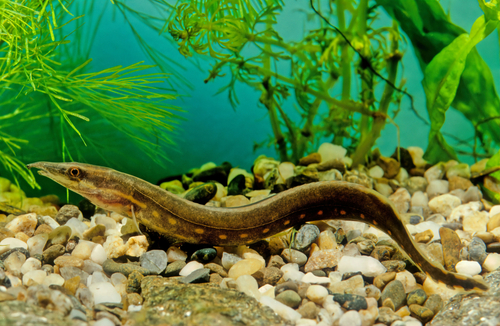
- Scientific Name: Mastacembelidae
- Diet: The spiny eel eats a lot of different things including tiny fish, invertebrates, and worms.
Spiny eels are a fairly substantial family of fish that all have their own distinguishing characteristics, but still look a lot like an eel. Once again, they aren’t true eels. Many spiny eels have a tube-like body like an eel, and many of them also have fins placed on the same parts of the body.
8. Moray Eel
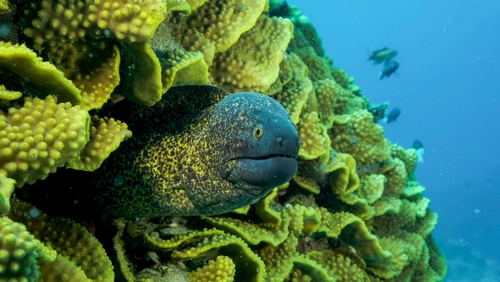
- Scientific Name: Muraenidae
- Diet: These fish are carnivores and like to eat other fish, crustaceans, and mollusks.
Moray eels are a family of fish that can be found in various bodies of water around the world, but they are also not actually eels. The moray eel is a fairly thick fish with a long body that gets thin towards the tail.
Their coloring is also similar to an eel, but eels aren’t as thick and they don’t have sharp teeth like a moray eel does.
9. Dragon Eel

- Scientific Name: Enchelycore pardalis
- Diet: This carnivorous fish likes eating any kind of fish that will fit inside its mouth, and also likes squid and crustaceans.
You’re hard-pressed to miss a dragon eel swimming by, with their bright orange bodies and speckles of white spots all over. That said, this coral-loving fish isn’t easy to spot in the wild. However, a dragon eel is not an eel either like many other fish on this list with eel in their name.
They do look similar to an eel in terms of having the same long bodies with similar fins on their bodies.
10. Zig Zag Eel

- Scientific Name: Mastacembelus Armatus
- Diet: The zig zag eel doesn’t mind scavenging, and likes to eat bugs, worms, larvae, and the occasional small fish.
The zig zag eel is not an eel, but they do look alike in terms of the signature snakelike appearance. This fish is much lighter in color and doesn’t grow to be as big as an eel does.
A zig zag eel likes to stay close to the bottom of the water, and they’re even known to burrow into plants sometimes.
11. West African Lungfish
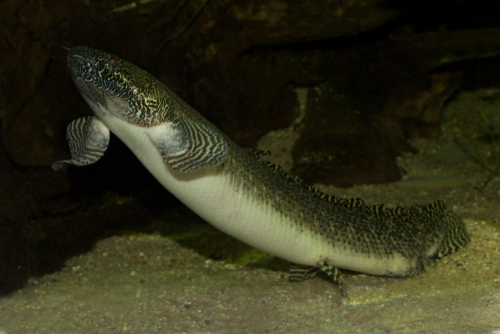
- Scientific Name: Protopterus annectens
- Diet: This fish is an omnivore and enjoys eating tree roots, seeds, frogs, and other fish.
The West African Lungfish can be found in various parts of Africa, and is comparable to an eel in terms of its body structure. As the name would suggest, the West African Lungfish actually has a set of lungs that it uses to breathe, unlike an eel. The pattern on this fish’s body also sets it apart from the eel.
When looking at this fish, it’s easy to see the resemblance to an eel in terms of its body structure, though their face actually looks more like a snake’s face.
Their pectoral fins are also big compared to their head. This fish is known to live up to 20 years, especially if they are well taken care of in an aquarium.
12. Reedfish
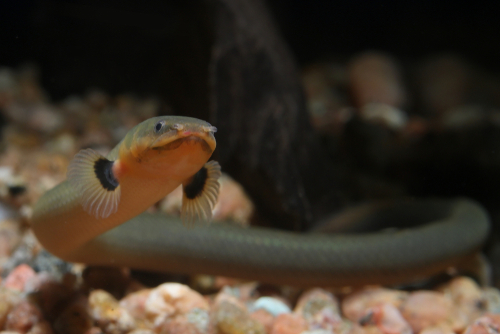
- Scientific Name: Erpetoichthys calabaricus
- Diet: Reedfish eat a variety of things, including worms, bugs, larvae, and fish.
The reedfish, also often called the ropefish, swims about freshwaters in some regions of Africa. They swim very similarly to an eel thanks to their small pectoral fins that help them gain momentum.
They look very similar to a snake in terms of their skin pattern, and tend to be a mixture of green and brown.
The reedfish can easily be mistaken for an eel because of their thin bodies, which also possess the same kind of slipper texture that an eel does. Otherwise, the reedfish is tiny compared to an eel, and they also have lungs and several very small spines, which an eel doesn’t.
13. Peacock Eel
- Scientific Name: Macrognathus siamensis
- Diet: The peacock eel likes to eat worms, larvae, and crustaceans.
The peacock eel is another fish that isn’t an eel despite how comparable they are. This fish’s long body has a series of spots and similar coloring to a peacock; hence, its name. A peacock eel can grow to be about one foot long at the most, making them much smaller than a typical eel.
14. Gollum Snakehead
- Scientific Name: Aenigmachanna gollum
- Diet: The Gollum snakehead is known to eat anything from small fish and invertebrates to small birds and reptiles.
The Gollum snakehead is one that’s usually only found in India, particularly in the southwestern region. This fish looks very much like an eel, but can be distinguished from one because of its thin fins that run along both the top and bottom of their body.
The Gollum snakehead also swims about the water the same way an eel does by using its pectoral fins. While an eel can grow to be large, the Gollum snakehead doesn’t. They also breathe in air just like the rest of the snakehead family.
15. Eel-Tailed Catfish
- Scientific Name: Tandanus tandanus
- Diet: An eel-tailed catfish’s diet varies depending on size; they eat anything from algae to shrimp to insects and their larvae.
The eel-tailed catfish is found in Australia and bears a lot of similarities to the eel. As can be expected by the name, their tails are long and thin, getting thinner towards the end.
The lower half of an eel-tailed catfish’s body also looks like an eel, though the top half doesn’t. Their fins somewhat resemble an eel’s as well, though an eel-tailed catfish has deadly fins.
16. Dragon Goby
- Scientific Name: Gobioides broussonnetii
- Diet: The dragon goby is a scavenging omnivore that eats bloodworms, algae, and anything else that fits in their small mouths.
Dragon gobies are a gorgeous fish with a body that looks a lot like an eel. Where they differ is in their stunning coloring, which ranges from violet to sapphire to a range of vibrant blues. The dragon goby has a long fin that runs along its back unlike an eel.
While a dragon goby can grow to be a substantial size compared to other gobies, they don’t grow as long as eels do.
17. Cutlassfish
- Scientific Name: Trichiuridae
- Diet: The cutlassfish typically eats small fish and shrimps.
One can find cutlassfish roaming around a few of the world’s oceans, and they’d be fairly easy to pick out of the water due to how uncommon they look.
Like an eel, the cutlassfish doesn’t have any scales on its body. Unlike some other fish similar to eels, a cutlassfish can grow to be three feet long, mimicking the average size of the eel.
The cutlassfish is quite a beautiful and mystical-looking fish, donning an iridescent silver and blue color and a very thin tail. They also have very pronounced eyes and big, pointed teeth and fangs.

Ian Sterling, founder of Fishlab.com, began his aquarium journey over 30 years ago, driven by a deep fascination for fish and their diverse personalities. His website, Fishlab.com, is dedicated to making fishkeeping accessible and enjoyable, offering beginner-friendly guidance, expert insights, and a community for aquarists to connect and share experiences.


